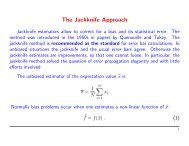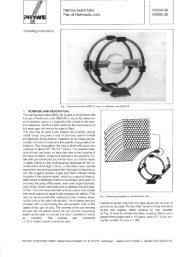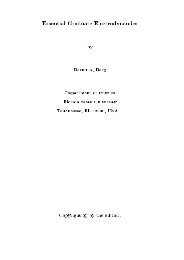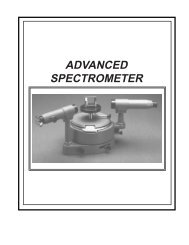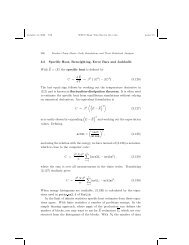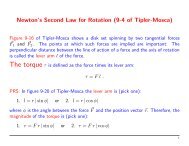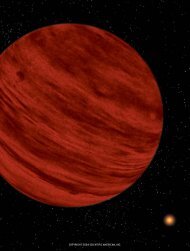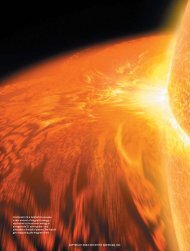The Stellar Dynamo - Scientific American Digital
The Stellar Dynamo - Scientific American Digital
The Stellar Dynamo - Scientific American Digital
- No tags were found...
You also want an ePaper? Increase the reach of your titles
YUMPU automatically turns print PDFs into web optimized ePapers that Google loves.
a b c<br />
North<br />
Pole<br />
North<br />
Pole<br />
North<br />
Pole<br />
SOLAR DYNAMO generates the sun’s magnetic field and also causes it to change orientation every<br />
11 years. Suppose that the initial magnetic field (a) resembles that of a bar magnet with its north<br />
pole (+) near the sun’s geographic north pole. <strong>The</strong> magnetic field lines are carried along with the<br />
electrically charged gases. <strong>The</strong> faster flow at the equator therefore distorts the field lines (b) until<br />
they wrap tightly (c) around the sun. But the field lines then resist the stretching and unwind,<br />
QUADRUPOLE<br />
DIPOLE<br />
<strong>The</strong> first description of how the sun’s<br />
gases conspire to create a magnetic field<br />
was proposed in 1955 by Eugene N.<br />
Parker of the University of Chicago. Because<br />
of the high temperature, the atoms<br />
of hydrogen and helium lose their electrons,<br />
thereby giving rise to an electrically<br />
charged substance, or plasma. As<br />
the charged particles move, they generate<br />
magnetic fields. Recall that the lines<br />
describing magnetic fields form continuous<br />
loops, having no beginning or<br />
end—their density (how closely together<br />
the lines are packed) indicates the intensity<br />
of the magnetic field, whereas<br />
their orientation reveals the direction.<br />
Because plasma conducts electricity very<br />
efficiently, it tends to trap the field lines:<br />
if the lines were to move through the<br />
plasma, they would generate a large, and<br />
energetically expensive, electric current.<br />
Thus, the magnetic fields are carried<br />
along with the plasma and end up getting<br />
twisted. <strong>The</strong> entwined ropes wrap<br />
together fields of opposite polarity, which<br />
tend to cancel each other. But the sun’s<br />
rotation generates organizational forces<br />
that periodically sort out the tangles and<br />
create an overall magnetic field. This automatic<br />
engine, which generates magnetism<br />
from the flow of electricity, is the<br />
solar dynamo.<br />
<strong>The</strong> dynamo has two essential ingredients:<br />
the convective cyclones and the<br />
sun’s nonuniform rotation. During the<br />
mid-1800s, Richard C. Carrington, an<br />
English amateur astronomer, found that<br />
the sunspots near the equator rotate faster,<br />
by 2 percent, than those at midlatitudes.<br />
Because the spots are floating with<br />
the plasma, the finding indicates that the<br />
sun’s surface rotates at varying speeds.<br />
<strong>The</strong> rotation period is roughly 25 days at<br />
the equator, 28 days at a latitude of 45<br />
degrees and still longer at higher latitudes.<br />
This differential rotation should extend<br />
all the way through the convective zone.<br />
Now suppose that the initial shape of<br />
the sun’s field is that of a dipole oriented<br />
roughly north-south. <strong>The</strong> field lines get<br />
pulled forward at the equator by the<br />
faster rotation and are deformed in the<br />
east-west direction. Ultimately, they lie<br />
parallel to the equator and float to the<br />
surface, erupting as pairs of sunspots.<br />
But Coriolis forces tend to align the<br />
cyclones and thereby the sunspots, which<br />
are constrained to follow the plasma’s<br />
gyrations. <strong>The</strong> cyclones arrange the sunspots<br />
so that, for example, a trailing sunspot<br />
in the northern hemisphere lies at<br />
a slightly higher latitude than a leading<br />
one. As the equatorial field lines are<br />
stretched, they eventually unwind and<br />
drift outward. <strong>The</strong> trailing sunspot<br />
reaches the pole first, effectively reversing<br />
the magnetic field there. (Recall that<br />
the trailing spot has a polarity opposite<br />
that of the nearest pole.) Those field lines<br />
that initially extended far beyond the<br />
sun reconnect into loops and are blown<br />
away by the solar wind. In this manner,<br />
the overall magnetic field flips, and the<br />
cycle begins again.<br />
<strong>The</strong>re is, however, a caveat. This simple<br />
picture seems to be at odds with results<br />
from helioseismology, the science of<br />
sunquakes. <strong>The</strong> model requires the sun<br />
to rotate faster at the interior; in contrast,<br />
results from the Global Oscillation Network<br />
Group, an international collaboration<br />
of observatories, show that the rotation<br />
velocity near the equator decreases<br />
downward. Such experiments are<br />
providing accurate information on internal<br />
motions of the sun and thereby help-<br />
PETER SAMEK Slim Films<br />
38 SCIENTIFIC AMERICAN THE SECRET LIVES OF STARS<br />
COPYRIGHT 2004 SCIENTIFIC AMERICAN, INC.



